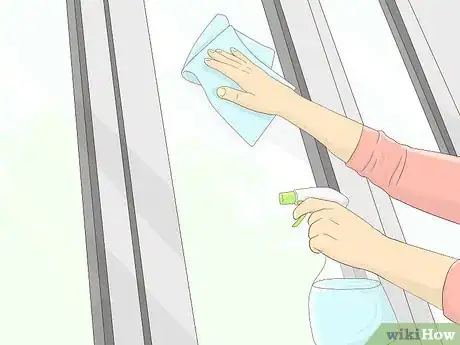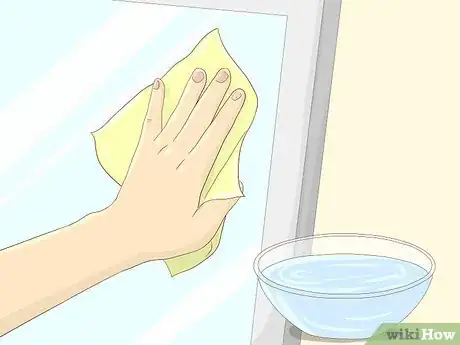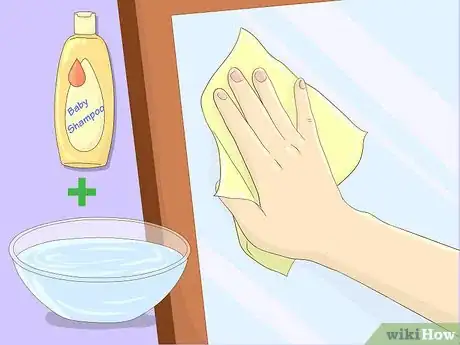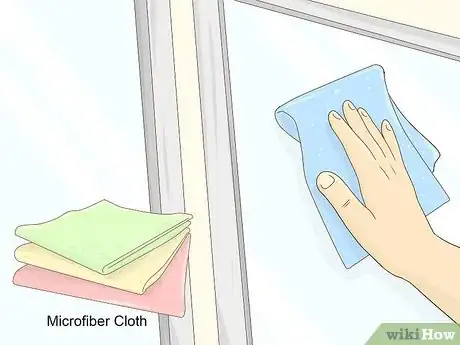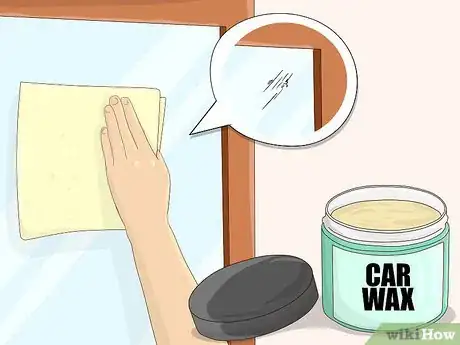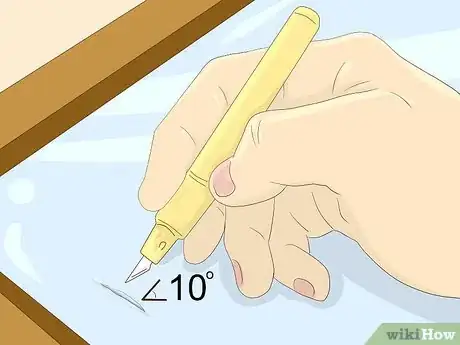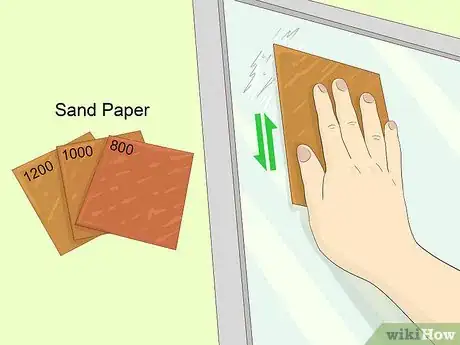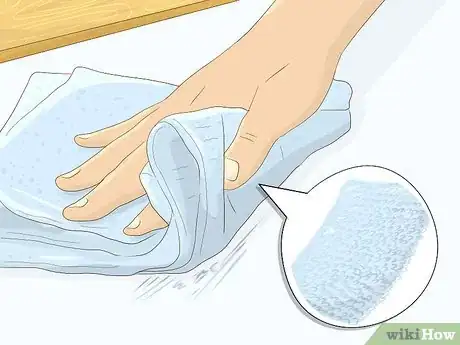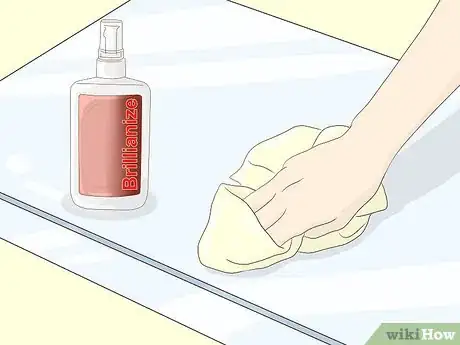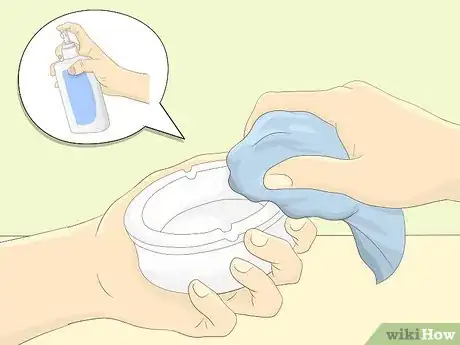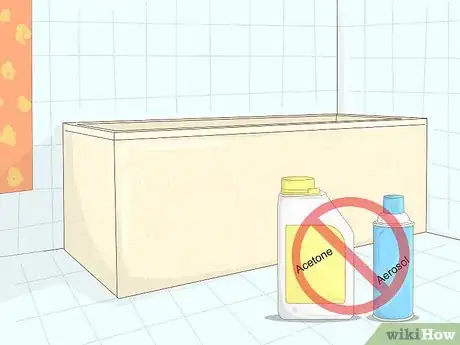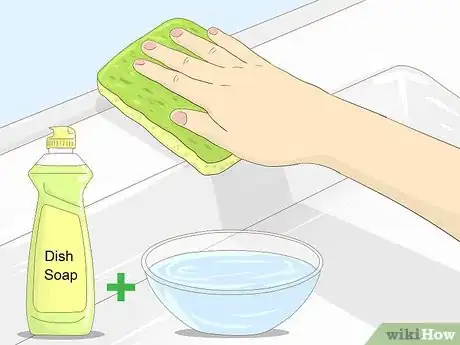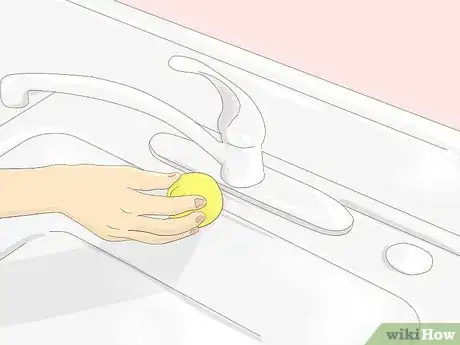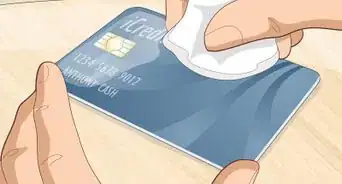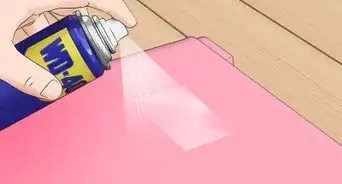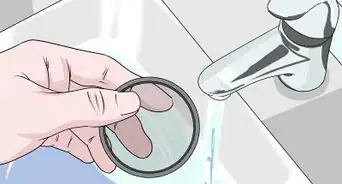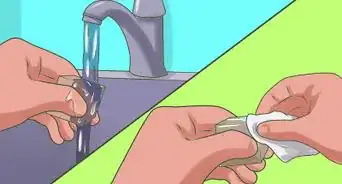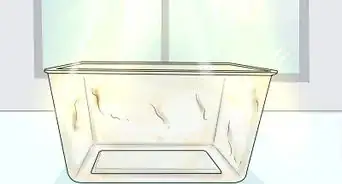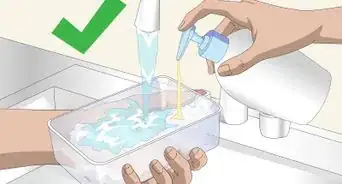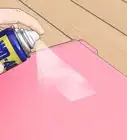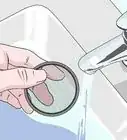This article was co-authored by Claudia & Angelo Zimmermann. Claudia and Angelo Zimmermann are the founders of Everneat, an Eco-Friendly Cleaning Service based in New York City and in Connecticut. They are also the founders of Clean Code, a DIY 100% natural cleaning product line.
This article has been viewed 74,401 times.
Cleaning acrylic – whether it’s furniture or picture frames – can be difficult because of how easily acrylic can scratch and how sensitive it is to certain cleaners. By preparing the acrylic you’re about to clean and using the cleaners appropriate to the type of acrylic you’re working on, you can clean your acrylic without damaging it.
Steps
Cleaning Acrylic Windows
-
1Blow dirt or dust off the window. Because acrylic is easily scratched, you don’t want to just wipe away any dirt or dust that is on the surface of the window. Instead, use air or water to remove dirt before you begin to clean. You can use canned air to blow dirt off of the windows, or drip water onto the surface that picks up the dirt and allows you to float it off.[1]
- If you use water, blot the window dry with a microfiber cloth after the dirt has come up.
-
2Use clear water to clean lightly soiled acrylic. If your acrylic window still needs a bit of cleaning after you've removed the top layer of dust and dirt, use clear water to clean it. Simply repeat the process of dropping water onto the surface of the acrylic and blot it dry with a microfiber cloth.[2]
- Don’t rub the window with the microfiber cloth as this can cause scratches in the acrylic.
Advertisement -
3Use a non-abrasive cleaner on dirtier windows. If you’re washing particularly dirty or outside-facing windows, mix equal parts non-abrasive cleaner and water to make a cleaning solution. Then dip a microfiber cloth in the solution and gently blot the acrylic surface clean.[3]
- Good non-abrasive cleaners for this type of cleaning are castile soap, baby shampoo, or Woolite or Dreft.
-
4Blot the surface dry. Once you’re done cleaning the acrylic window, use a dry microfiber cloth to blot the surface of the window dry. Avoid wiping the cloth across the surface of the window as this can cause scratches.[4]
-
5Remove scratches using car wax. If, once you’ve cleaned the window, you discover scratches in the surface, you can use car wax to remove them. Apply wax to the areas that are scratched and use the buffer that comes with the wax to buff the surface.[5]
- If you’ve never buffed a surface before, proceed for gently with this step.
-
6Scrape the surface. If you have very deep scratches in the acrylic, you scrape the surface of the acrylic. Hold a sharp scarping tool at a 10 degree angle and move it from side to side, evenly and gently scraping off the excess.[6]
- This technique should only be used for very, very deep scratches.
-
7Sand the surface. Sanding the surface of acrylic gives it a matte finish, which gives it a frosted look. You can perform this technique with sand paper by hand, or with sanding tools. Simply sand the acrylic surface the same way you would with a piece of wood – start with a coarser sand paper and once you’ve worked over the entire surface, move to a finer paper and repeat the process.[7]
- Using a buffer after you sand acrylic can give your acrylic an extra shiny finish.
- This technique should only be used on unfinished acrylic or if your acrylic windows have suffered extreme damage from storms.
Cleaning Acrylic Furniture
-
1Avoid using dusting cloths. The biggest concern with acrylic furniture is the risk of scratching. When you’re prepping the surface of your acrylic furniture, avoid using a dusting cloth to remove dirt and dust. These types of cloths can trap particles that won’t seem big to the naked eye, but will scratch your furniture. Use a clean microfiber cloth instead.[8]
-
2Use cleaners specifically designed for plastics. Even though acrylic furniture is clear, you shouldn’t use the same cleaners that you do on glass windows to clean it. Cleaners specifically made for plastics, like Brillianize cleaner, is the best option for cleaning your acrylic furniture. It prevents scratches and won’t leave a film on the surface or break down the acrylic, giving it a cloudy appearance.[9]
-
3Clean small areas at a time. Squirt a small amount of cleaner onto the piece of furniture you’re cleaning and then polish that area with your cloth. Once you’re done with that small area, move on to the next. Don’t spray the whole piece of furniture and then wipe it down.[10]
Cleaning Acrylic Tubs
-
1Don’t use aerosol cleaners on acrylic bath tubs. When cleaning an acrylic bath tub, avoid using any aerosol or acetone cleaners. The chemicals in those cleaners can eat through the acrylic of your tub.[11]
-
2Use mild dish soap on acrylic tubs. To clean acrylic bathtubs, use a mild dish soap with warm water. Wet the sides of the tub and a soft sponge with warm water. Apply a small amount of a mild dish soap to the sponge and gently scrub the tub.[12]
- You should avoid using wire brushes or scrubbing pads as these can scratch the acrylic and ruin it.
-
3Use lemons to remove hard water stains. Instead of using cleanser on hard water stains on your bathtub, try rubbing lemons over the stains. Let the lemon juice sit on the stain for a few minutes, and then rinse with water and before drying it with a microfiber cloth.[13]
Community Q&A
-
QuestionHow can I remove drops of hair color from white acrylic surfaces?
 Community AnswerYou should use a mix of baking soda, dish detergent, and water which will make a paste that should be able to remove it.
Community AnswerYou should use a mix of baking soda, dish detergent, and water which will make a paste that should be able to remove it.
Expert Interview
Thanks for reading our article! If you'd like to learn more about cleaning acrylic, check out our in-depth interview with Claudia & Angelo Zimmermann.
References
- ↑ http://www.eplastics.com/Plastic/eplastics_how_to_videos/cleaning-plexiglass-video
- ↑ http://www.displays2go.com/Guide/Tips-Cleaning-Plexiglass-Acrylic-22
- ↑ http://www.howtocleanstuff.net/how-to-clean-acrylic-glass/
- ↑ http://www.displays2go.com/Guide/Tips-Cleaning-Plexiglass-Acrylic-22
- ↑ http://www.howtocleanstuff.net/how-to-clean-acrylic-glass/
- ↑ http://www.displays2go.com/Guide/Tips-Cleaning-Plexiglass-Acrylic-22
- ↑ http://www.displays2go.com/Guide/Tips-Cleaning-Plexiglass-Acrylic-22
- ↑ http://www.howtodecorate.com/2015/12/how-to-clean-acrylic-furniture-accessories/
- ↑ http://www.howtodecorate.com/2015/12/how-to-clean-acrylic-furniture-accessories/
- ↑ http://www.howtodecorate.com/2015/12/how-to-clean-acrylic-furniture-accessories/
- ↑ https://www.angieslist.com/articles/how-clean-acrylic-bathtub-correctly.htm
- ↑ https://www.angieslist.com/articles/how-clean-acrylic-bathtub-correctly.htm
- ↑ https://www.angieslist.com/articles/how-clean-acrylic-bathtub-correctly.htm
About This Article
Acrylic can be difficult to clean because of how easily it’s scratched, but by using the right cleaner, you can avoid damaging it. For acrylic windows, use water or a non-abrasive cleaner such as castile soap or baby shampoo and a microfiber cloth to gently blot the surface clean. To clean acrylic furniture, use a cleaner designed for plastic, like Brillianize cleaner, and clean small areas at a time with a microfiber cloth to prevent scratches. To clean acrylic tubs, wet a soft sponge with warm water and add a small amount of a mild dish soap to the sponge. Gently scrub the tub with the sponge to clean it. If the tub has hard water stains, rub lemons over them, then rinse the tub with water. For tips about how to remove scratches from acrylic, keep reading!
